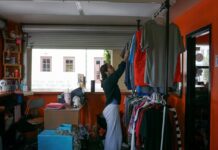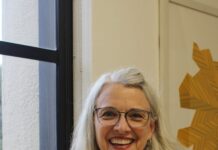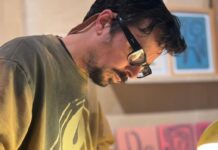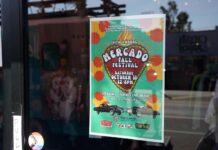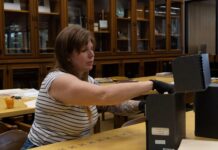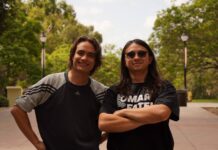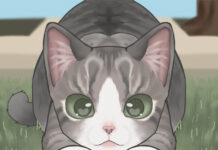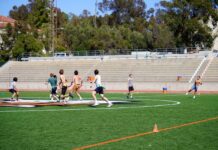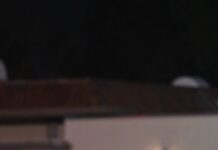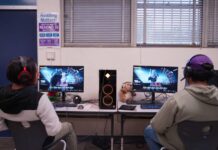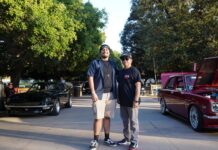Author: Kelly Neukom
On July 29, Occidental students across the country did a double take while flipping through the Education supplement in the Sunday edition of the New York Times. However, the college didn’t attract nation-wide interest for its professors or classes, but rather for its students and their tendency to walk barefoot.
Brennan Lake (junior) is one student who prefers to live life free of shoes. “I walk around pretty much everywhere barefoot, indoors and outdoors,” he said. “People always ask me why I don’t wear shoes and I never have a clear answer, but I suppose it has a lot to do with convenience. It’s one less thing to worry about before you walk out the door. I also like being aware of what’s beneath me – you really get to know your surroundings.”
Tessa D’Arcangelew (sophomore) agrees. She started wearing soft-soled moccasins and realized she enjoyed the sensation. “I like feeling my environment on [the] bottom of my feet,” she said. “It’s an all-dimensional experience of world. I’m more aware of where I’m walking. I like that. I notice more. My toes get claustrophobic in shoes.”
Joe Statwick (junior) also prefers to walk barefoot, but has a very simple reason why. “It’s pretty much the same reason I don’t usually wear a hat,” Statwick said. “Most of the time, I just don’t really feel like it.”
Kyna Shilling ’07 found that many students were similar to Statwick in this respect when she was approached by a Times editor to take pictures of barefoot students on campus.
“The first half of the assignment consisted primarily of barefoot subjects photographed in the quad, Marketplace and Cooler,” she said. “I was surprised at how many people I found without shoes wandering around campus during lunch! The second batch of photos was indoor shots, taken during my classes and in the library. Sometimes a third of students in my classes would take their shoes off during lectures or come barefoot to class. The quad and the library were the two places I found people without shoes most frequently.”
Lake said there are very few times when he does wear shoes – walking to the taco truck (“it can get pretty grungy around there what with all the taco residue splattered about the sidewalk”), at fancy restaurants (“although sometimes I like to elude the employees of these establishments; it’s pretty funny wearing a full suit and tie with no shoes!”) and when he sees his grandmother.
“The only person who really tries to get me to put shoes on is my grandma, and I usually submit to her because Italian grandmothers are really good at guilt tripping,” Lake said.
“I wear [shoes] when I have lab and closed-toed shoes are required or when I have to go off campus to some sort of place where they’ll kick me out for not wearing them,” Statwick said.
D’Arcangelew said she wears shoes for “interviews and important things.” “No matter what type of candidate I was, people interviewing me would say, ‘She wasn’t wearing shoes!'” she said. “It’s too radical for some people.”
As for the hazards of going shoeless, both Lake and Statwick have stepped on glass (Lake three or four times, Statwick once) and cite stepping on bees and breaking toes as other casualties. “I’ve had my tetanus shot and I’ve never in my life gotten athletes foot or anything like that, so I’m really not too worried,” Statwick said. Lake is quick to add that the times he stepped on glass were when he was drinking and likes to think that is what caused the accidents.
And for D’Arcangelew? “There are a lot of things I’m more concerned about than my feet,” she said simply. She said her feet actually stay cleaner when she walks barefoot in comparison with when she wears flip-flops. “My feet don’t get dirty because I walk through so many different environments,” she said. “It cleans them off. My feet look dirtier when I wear flip-flops because they get sweaty and the dirt sticks to them.”
The Wall Street Journal article “Is Barefoot Better?” reported that some experts now believe exercising barefoot is much better for a runner’s health than wearing expensive sneakers. “[Athletic shoes] may actually be making your feet lazy, weak and more prone to injury,” it said. “As a result, barefoot training is gaining more attention among coaches, personal trainers and runners. While exercising without shoes may sound painful, the idea is that your feet need a workout, too. Proponents believe running barefoot changes a runner’s form and body mechanics to prevent some common athletic injuries.”
In fact, Nike is now marketing a shoe called Nike Free that claims it imitates the feeling of running barefoot. It has three different versions of the shoe (7.0, 5.0 and 3.0) and the smaller the number, the closer it is to being barefoot.
“Since [the Nike Free] simulates what happens out there barefoot on grass, you’re getting more of a range of motion at the ankle joint… [and] at the ball of the foot,” Senior Biomechanics Researcher Jeff Pisciotta said in a video on the website. “Having that enhanced motion is going to help enhance flexibility. You’re also utilizing some of the very smaller, intrinsic muscles of the foot that don’t normally get utilized in everyday training or in typical footwear.”
Despite students’ enthusiasm for walking around with nothing on their feet, none of the students interviewed consider it a trend.
“Think about it – it was the status quo for thousands of years,” Lake said. “I’ve never been there, but I hear that a lot of people in Fiji don’t wear shoes by choice. I don’t think you could call that trendy.”
Statwick agrees. “There are a lot of people all over the world who just don’t have shoes to wear, so I’d be hesitant to call something that’s associated with extreme impoverishment ‘trendy,'” he said. “Though some might argue that looking like you are dying of starvation is ‘trendy’ too, so I don’t really know.”
Shilling used to go sans shoes in high school, but said, “I think it is more a product of laziness than fashion, although it’s a great way to show off a cute pedicure.”
She was surprised to find that colleges in colder climates than Occidental have also reported students roaming barefoot. “What I think is interesting is that the other school selected by the [Times] to profile this ‘upcoming trend’ was Reed College in Oregon, where, unlike southern California, the average temperature is 50 degrees and raining,” she said.
“If students in Portland report bare feet as a campus trend, then it seems likely that colleges in warmer states would happily adopt the fashion statement in a more comfortable climate!”
But D’Arcangelew doesn’t expect everyone to suddenly become barefoot converts. “It’s more of a phenomenon,” D’Arcangelew said. “It’s not like a lot of people will participate, but it’s become normal to them to see other people barefoot. Not having shoes is accepted rather than trendy.”
“I guess I would recommend walking barefoot to others if they were considering it,” Lake said. “Otherwise, heck – rocking shoes is fine too.”
This article has been archived, for more requests please contact us via the support system.
![]()




